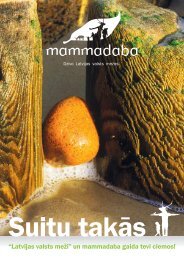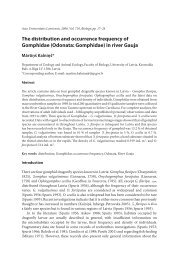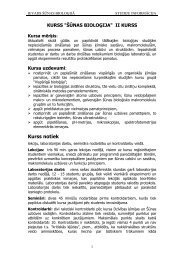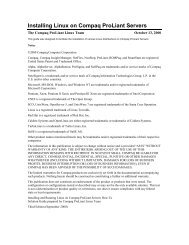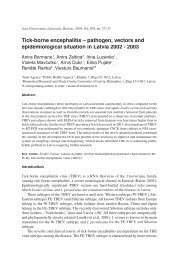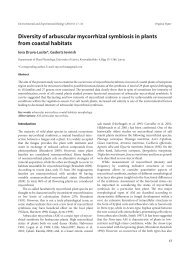Biohydrogen production in anaerobic fluidized bed reactors: Effect of ...
Biohydrogen production in anaerobic fluidized bed reactors: Effect of ...
Biohydrogen production in anaerobic fluidized bed reactors: Effect of ...
You also want an ePaper? Increase the reach of your titles
YUMPU automatically turns print PDFs into web optimized ePapers that Google loves.
ema<strong>in</strong>ed virtually constant as HRT decreased from 8 to 4 h,<br />
with values rang<strong>in</strong>g between 80.66 and 83.70%. When the HRT<br />
decreased to 2 h and 1 h, glucose conversion rates <strong>in</strong> R1<br />
dropped to 59.54 and 49.11%. Reactor R2 (expanded clay)<br />
showed similar behavior, with glucose conversion values<br />
rang<strong>in</strong>g between 88.20 and 96.30% for HRTs from 8 to 4 h.<br />
These values decreased to 76.30 and 70.50% when HRT was<br />
decreased to 2 h and 1 h, respectively. The higher glucose<br />
conversion rate obta<strong>in</strong>ed <strong>in</strong> R2 re<strong>in</strong>forces the superior<br />
performance <strong>of</strong> this reactor for fermentative H 2 <strong>production</strong>.<br />
The high values <strong>of</strong> substrate conversion achieved are consistent<br />
with comparable studies <strong>in</strong> AFBRs us<strong>in</strong>g glucose [32–35]<br />
and sucrose [31]. These high rates may be attributed to the<br />
high accumulation <strong>of</strong> biomass <strong>in</strong> the system, which is an<br />
advantageous feature <strong>of</strong> adhered-growth systems [50].<br />
Sucrose conversions rang<strong>in</strong>g from 92–99% were obta<strong>in</strong>ed by<br />
L<strong>in</strong> et al. [31] <strong>in</strong> AFBRs us<strong>in</strong>g HRTs decreas<strong>in</strong>g from 8.9 to 2.2 h.<br />
Similar results (glucose conversions <strong>of</strong> 89–98%) were verified<br />
by Amorim et al. [34] and Shida et al. [35] <strong>in</strong> AFBRs us<strong>in</strong>g HRTs<br />
rang<strong>in</strong>g from 8 to 1 h. However, Zhang et al. [32] verified<br />
glucose conversions rang<strong>in</strong>g from 99.47% to 71.44% when HRT<br />
was decreased from 4 to 0.5 h. Although the present study has<br />
also achieved lower glucose conversions, most <strong>of</strong> the<br />
Glucose concentration (mg L<br />
-1<br />
)<br />
3384<br />
<strong>in</strong>ternational journal <strong>of</strong> hydrogen energy 35 (2010) 3379–3388<br />
Table 3 – Production <strong>of</strong> soluble metabolites <strong>in</strong> H 2 <strong>production</strong> under different operat<strong>in</strong>g conditions <strong>in</strong> AFBRs.<br />
Polystyrene (R1)<br />
Expanded clay (R2)<br />
HRT (h)<br />
HRT (h)<br />
8 6 4 2 1 8 6 4 2 1<br />
pH 5.87 5.36 5.68 5.67 5.72 5.42 5.00 4.92 5.59 5.69<br />
TVFA (mM) 13.49 0.34 18.20 0.53 17.78 0.83 17.67 0.39 5.80 0.94 14.60 0.23 21.42 0.47 23.98 0.91 24.13 0.44 18.42 0.88<br />
SMP (mM) 21.91 0.45 26.33 0.62 24.53 0.91 19.62 0.43 7.54 0.98 18.94 0.31 26.85 0.52 26.70 0.93 28.48 0.55 20.70 0.91<br />
Eth/SMP (%) 38.41 30.89 27.53 9.97 23.07 22.95 20.24 10.18 15.27 11.02<br />
HAc/SMP (%) 27.38 34.18 38.22 49.05 38.25 32.99 37.24 46.81 45.06 43.74<br />
HBu/SMP (%) 31.12 31.08 30.40 38.22 33.30 40.49 41.26 41.49 37.30 40.34<br />
HPr/SMP (%) 3.08 3.85 3.86 2.75 5.38 3.57 1.26 1.52 2.37 4.90<br />
HAc/HBu 0.88 1.10 1.26 1.28 1.15 0.81 0.90 1.13 1.21 1.08<br />
HAc: acetate, HBu: butyrate, EtOH: ethanol, TVFA = HAc þ HBu þ HPr, SMP ¼ TVFA þ EtOH, EtOH/SMP: molar ethanol to SMP ratio, HAc/SMP:<br />
molar acetate to SMP ratio, HBu/SMP: molar butyrate to SMP ratio, HAc/HBu: molar acetate to butyrate ratio.<br />
4500<br />
4000<br />
3500<br />
3000<br />
2500<br />
2000<br />
1500<br />
1000<br />
500<br />
Influent glucose - R1<br />
Influent glucose - R2<br />
Glucose conversion - R1<br />
Glucose conversion - R2<br />
0<br />
0<br />
0 1 2 3 4 5 6 7 8 9<br />
HRT (h)<br />
Fig. 4 – <strong>Effect</strong> <strong>of</strong> HRT on the glucose concentration and<br />
glucose conversion <strong>in</strong> the AFBRs conta<strong>in</strong><strong>in</strong>g polystyrene<br />
(R1) and expanded clay (R2).<br />
100<br />
80<br />
60<br />
40<br />
20<br />
Glucose conversion (%)<br />
substrate was channeled to f<strong>in</strong>al product reactions <strong>in</strong>stead <strong>of</strong><br />
bacterial growth and ma<strong>in</strong>tenance [32,35]<br />
3.3. Attached biomass and extracellular polymeric<br />
substances<br />
It is generally believed that hydrogen <strong>production</strong> rates are<br />
closely related to the dom<strong>in</strong>ant microorganisms and environmental<br />
conditions present dur<strong>in</strong>g <strong>anaerobic</strong> fermentation but<br />
are <strong>in</strong>dependent <strong>of</strong> reactor configuration. For example,<br />
a hydrogen yield <strong>production</strong> equivalent to 1.6–2.1 mol H 2 mol 1<br />
glucose was achieved <strong>in</strong> a CSTR reactor [47], a UASB reactor [18]<br />
and a fixed <strong>bed</strong> reactor [48] us<strong>in</strong>g mixed cultures rich <strong>in</strong> Clostridium<br />
sp. Fig. 5 shows that micro-shaped bacilli resembl<strong>in</strong>g<br />
Clostridium sp. are dom<strong>in</strong>ant <strong>in</strong> the bi<strong>of</strong>ilm. Also, the maximum<br />
HY (2.52 mol H 2 mol 1 glucose) obta<strong>in</strong>ed <strong>in</strong> this study was<br />
similar the maximum obta<strong>in</strong>ed (2.45 mol H 2 mol 1 glucose)<br />
us<strong>in</strong>g a mixed culture rich <strong>in</strong> Clostridium sp. [9]. It seems likely<br />
that the low pH conditions <strong>in</strong>fluenced the efficiency <strong>of</strong> bacterial<br />
hydrogen formation <strong>in</strong> these experiments. In other studies,<br />
maximum HY occurred at an optimum pH range <strong>of</strong> 5.2–5.7, but<br />
decreased significantly when the pH dropped to 4.7 [10,51].<br />
These results can be expla<strong>in</strong>ed by the activity <strong>of</strong> hydrogenase,<br />
an enzyme <strong>in</strong> Clostridium sp. that is <strong>in</strong>hibited by low pH [49],<br />
although Clostridium butyricum activity was noticeable even at<br />
pH 4.0 [52]. Furthermore, additional substrates may be required<br />
to ma<strong>in</strong>ta<strong>in</strong> bacterial growth <strong>in</strong> stressed environments,<br />
result<strong>in</strong>g <strong>in</strong> lower than optimal hydrogen <strong>production</strong>.<br />
The SEM micrographs (Fig. 5) show that particles <strong>of</strong> polystyrene<br />
and expanded clay were appropriate support materials<br />
for biomass immobilization. However, the bi<strong>of</strong>ilms were<br />
not uniformly distributed on the particle surfaces; some<br />
areas were not covered (Fig. 5a, c). The <strong>production</strong> <strong>of</strong> acetic<br />
and butyric acids <strong>in</strong> the study conditions shows that the<br />
microorganisms <strong>in</strong> the <strong>in</strong>oculum were metabolically similar<br />
to Clostridium sp. and Bacillus sp. [9,53,54]. Thepresence<strong>of</strong><br />
these groups is probably related to their morphological use <strong>of</strong><br />
organic acids (such as acetate and butyrate) and to hydrogenotrophic<br />
metabolisms (H 2 /CO 2 ). These f<strong>in</strong>d<strong>in</strong>gs show that<br />
the heat treatment <strong>of</strong> the <strong>in</strong>oculum was important to<br />
<strong>in</strong>crease the conversion efficiency <strong>of</strong> glucose and H 2<br />
<strong>production</strong>.





